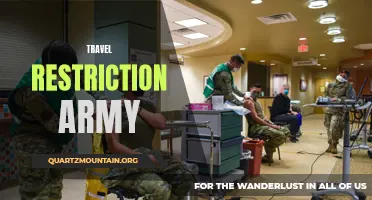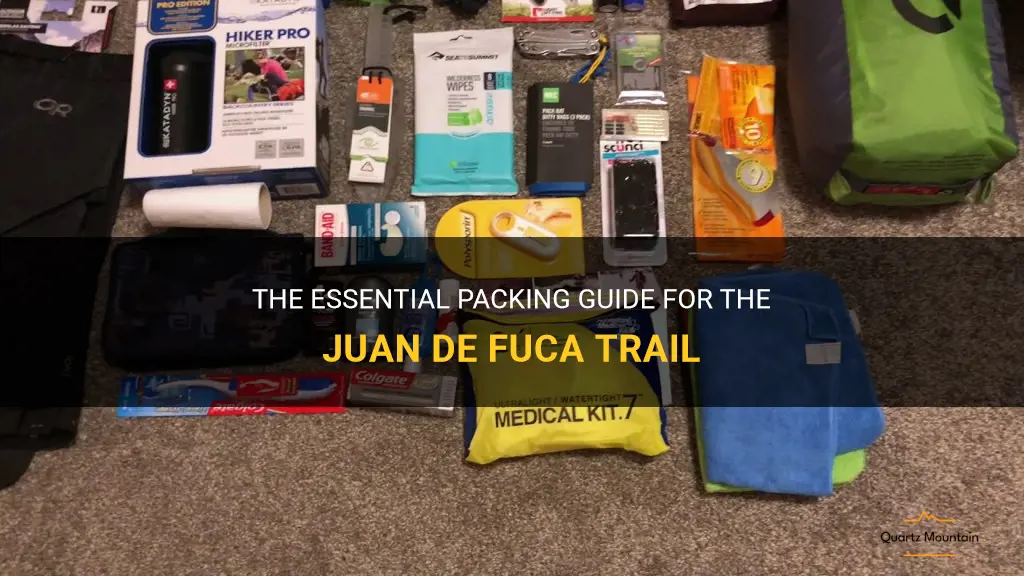
Embarking on an adventure through lush rainforests, rugged coastlines, and breathtaking vistas, the Juan de Fuca Trail offers an experience like no other. But before you set foot on this epic trail, it's essential to pack wisely - so you can fully embrace the beauty and challenges ahead. In this comprehensive packing guide, we will take you through everything you need to know to ensure you have the ultimate Juan de Fuca Trail experience, from clothing and camping gear to food and safety essentials. So grab your backpack and get ready to discover the essential items that will make your journey on the Juan de Fuca Trail an unforgettable one.
| Characteristics | Values |
|---|---|
| Distance | 47 kilometers |
| Duration | 4-5 days |
| Difficulty | Moderate to difficult |
| Terrain | Rocky, muddy, and uneven |
| Climate | Variable (rain, fog, and sun) |
| Water sources | Streams and rivers |
| Camping spots | Designated campsites |
| Wildlife | Bears, cougars, and deer |
| Scenery | Coastal rainforest |
| Clothing | Layered and waterproof |
| Footwear | Sturdy hiking boots |
| Tent | Lightweight and waterproof |
| Sleeping bag | Warm and compact |
| Backpack | Comfortable and adjustable |
| Emergency gear | First aid kit, whistle, and map |
| Food | Lightweight and non-perishable |
| Cooking stove | Portable and fuel-efficient |
| Utensils | Compact and lightweight |
| Trash bags | To pack out all garbage |
| Insect repellent | To prevent bug bites |
What You'll Learn
- What essential items should I pack for the Juan de Fuca Trail?
- Are there any specific clothing items that are recommended for the trail?
- Is it necessary to bring camping gear, or are there accommodations along the trail?
- Are there any special considerations for packing food on the Juan de Fuca Trail?
- Are there any specific safety items that should be included in my pack?

What essential items should I pack for the Juan de Fuca Trail?
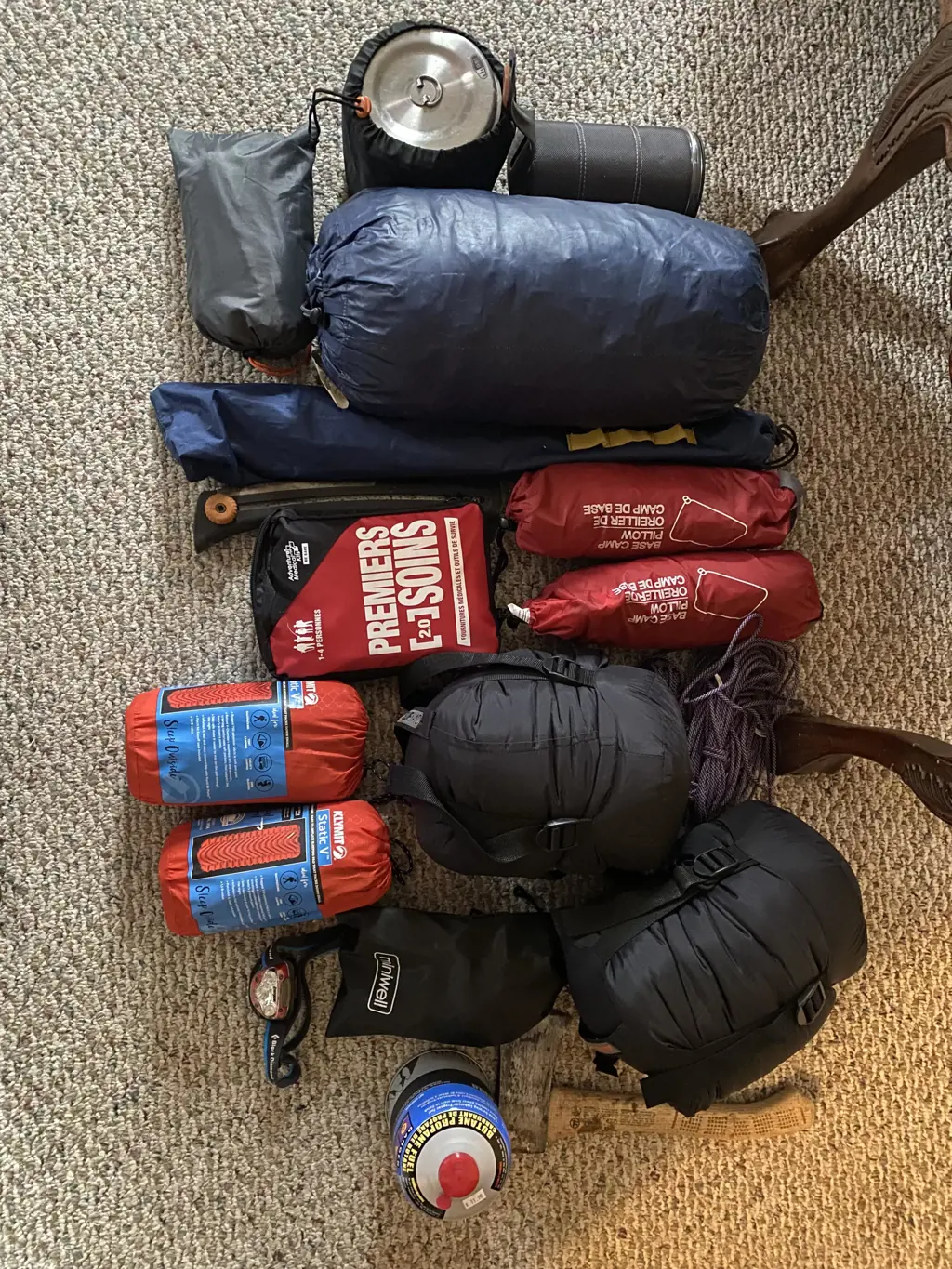
The Juan de Fuca Trail is a stunning coastal hiking trail located on Vancouver Island, British Columbia, Canada. Whether you're planning a day trip or a multi-day adventure along this wilderness trail, it's important to be prepared with the right essentials to ensure a safe and enjoyable experience. Here are some essential items you should pack for the Juan de Fuca Trail.
- Backpack: A sturdy backpack is essential for carrying all your gear and supplies. Look for a backpack with comfortable shoulder straps and a good hip belt for proper weight distribution.
- Navigation Tools: The Juan de Fuca Trail can be challenging to navigate, especially if you're unfamiliar with the area. Bring a map, compass, and a GPS device to help you find your way. It's also a good idea to download offline maps on your phone as a backup.
- Shelter: The weather along the trail can be unpredictable, so it's important to bring some form of shelter. A lightweight tent or a bivy sack can provide protection from rain and wind. Make sure your shelter is compact and easy to set up.
- Sleeping Bag and Sleeping Pad: Nights on the trail can get chilly, so bring a warm sleeping bag that is suitable for the expected weather conditions. A sleeping pad will provide insulation and cushioning for a more comfortable night's sleep.
- Food and Water: Pack enough food for the duration of your hike, plus a little extra in case of emergencies. Choose lightweight, high-energy foods that are easy to prepare. Don't forget to bring a water filter or water purification tablets to treat water found along the trail.
- Clothing: Dress in layers to adapt to the changing weather conditions. Bring a waterproof and breathable rain jacket, a warm fleece or down jacket, moisture-wicking shirts, quick-drying pants, and extra pairs of socks. Don't forget a hat, gloves, and a buff or bandana for sun protection.
- Hiking Boots or Shoes: Invest in a good pair of hiking boots or shoes that provide ankle support and have a grippy sole for traction on rugged terrain. Make sure your footwear is broken in before hitting the trail to avoid blisters and discomfort.
- First Aid Kit: Accidents can happen, so it's essential to carry a first aid kit. Include items like adhesive bandages, blister treatment, pain relievers, antiseptic wipes, and any necessary prescription medications.
- Headlamp and Extra Batteries: A headlamp is essential for navigating in low-light conditions or during early morning or late-night hikes. Pack extra batteries to ensure you won't be left in the dark.
- Personal Care Items: Don't forget basic personal care items such as sunscreen, insect repellent, toilet paper, and hand sanitizer. These small items can make a big difference in your comfort level on the trail.
- Trekking Poles: Consider bringing a pair of trekking poles to provide stability and reduce strain on your joints, especially if you're planning on tackling steep or uneven terrain.
- Emergency Whistle and a Signal Mirror: These items can be useful in case of an emergency. An emergency whistle can help to attract attention, while a signal mirror can be used to reflect sunlight and signal for help.
Remember, proper preparation is key to a successful hike on the Juan de Fuca Trail. Be sure to research and plan accordingly based on the length of your hike, weather conditions, and your personal abilities. Always practice Leave No Trace principles and respect the natural environment. Enjoy your adventure!
Packing Essentials for Your Clayoquot Wilderness Resort Adventure
You may want to see also

Are there any specific clothing items that are recommended for the trail?
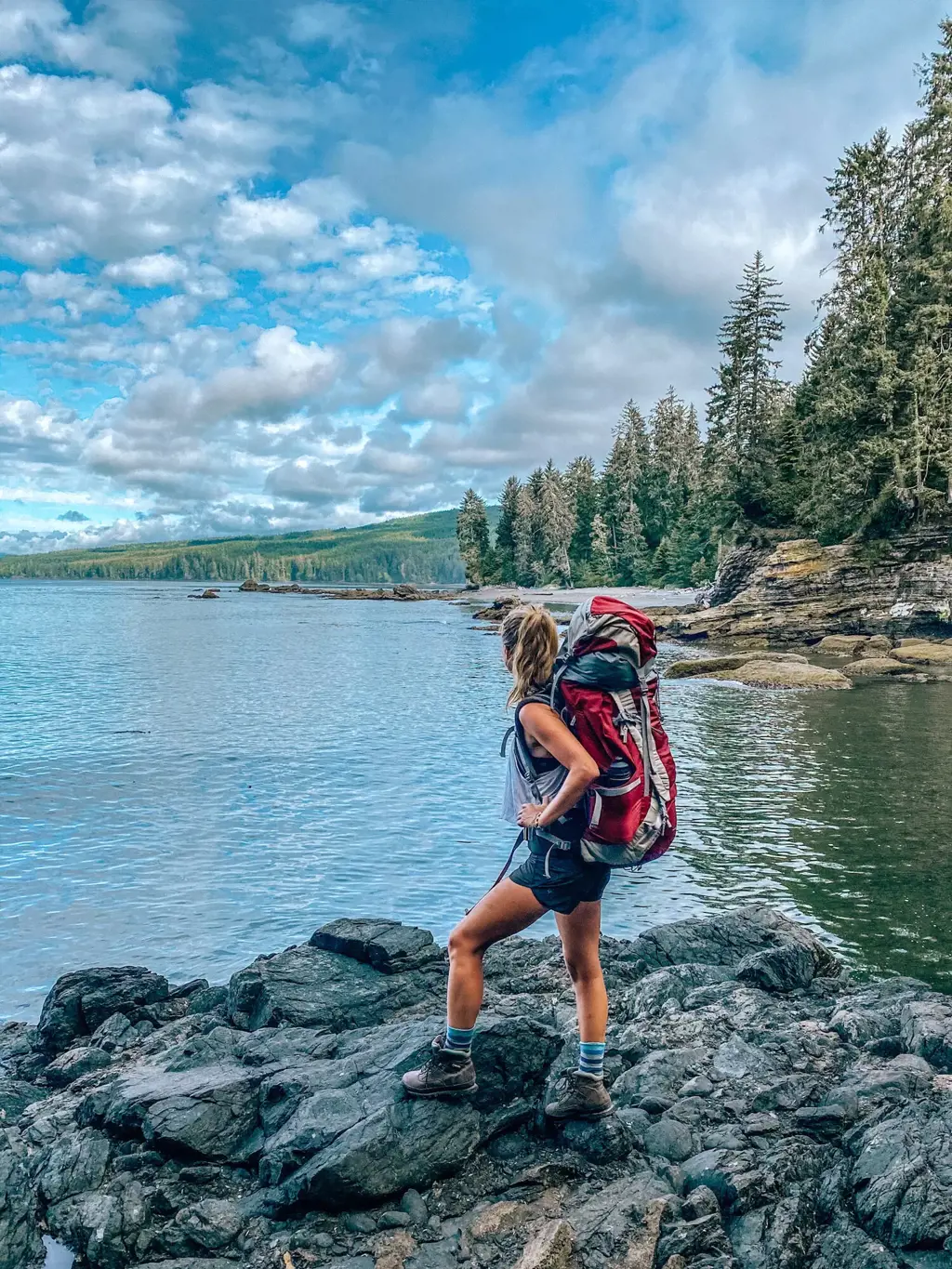
When planning a hiking or backpacking trip, it is important to choose the right clothing to ensure comfort and safety on the trail. While everyone has their own preferences, there are some specific clothing items that are generally recommended for hiking and backpacking. In this article, we will discuss these recommended clothing items and why they are important for the trail.
Moisture-Wicking Base Layers:
One of the most essential clothing items for the trail is a moisture-wicking base layer. This layer, typically made of synthetic materials like polyester or merino wool, helps to wick sweat away from your body, keeping you dry and comfortable. Moisture-wicking base layers are important because they help regulate your body temperature, keeping you cool in hot weather and warm in cold weather. They also prevent the accumulation of sweat, which can lead to discomfort and chafing.
Lightweight and Breathable Shirt:
When hiking or backpacking, it is important to wear a lightweight and breathable shirt. Look for shirts made of lightweight synthetic materials or merino wool, as they are quick-drying and odor-resistant. Avoid cotton shirts, as they retain moisture and can lead to discomfort and chafing.
Hiking Pants or Shorts:
For lower body clothing, choose hiking pants or shorts that are comfortable and allow for a wide range of motion. Look for pants or shorts made of durable and quick-drying materials like nylon or polyester. These materials are also resistant to tears and abrasions, which can be useful when hiking through rough terrain. Additionally, consider pants or shorts with built-in UV protection to protect your skin from the sun's harmful rays.
Insulating Layers:
Depending on the weather and the specific trail conditions, you may need to carry insulating layers like fleece jackets or down vests. These layers are lightweight and provide excellent insulation, helping to keep you warm in colder temperatures. Insulating layers should be easily packable so that you can easily carry them in your backpack.
Waterproof or Windproof Shell:
A waterproof or windproof shell is essential to protect you from rain, wind, and other harsh weather conditions. Look for jackets or raincoats made of durable and breathable materials like Gore-Tex. These jackets will keep you dry while allowing moisture to escape, preventing sweat from accumulating inside. It is important to note that waterproof or windproof shells are best used as outer layers and should be worn over other clothing items.
Proper Footwear:
Investing in a good pair of hiking boots or trail shoes is crucial for any hiking or backpacking trip. These shoes or boots should provide good traction, ankle support, and be comfortable to wear for long periods. Look for shoes or boots that are waterproof, breathable, and durable. It is recommended to break in your new footwear before hitting the trail to avoid blisters and discomfort.
Hats, Gloves, and Socks:
Don't forget to protect your extremities! For sun protection, wear a hat with a brim and sunglasses to shield your face and eyes from the sun's rays. In colder temperatures, wear gloves to keep your hands warm and protect them from windburn. Lastly, invest in moisture-wicking socks made of synthetic materials to prevent blisters and keep your feet dry and comfortable.
In conclusion, when planning a hike or backpacking trip, it is important to choose the right clothing to ensure comfort and safety on the trail. Moisture-wicking base layers, lightweight and breathable shirts, hiking pants or shorts, insulating layers, waterproof or windproof shells, proper footwear, and accessories like hats, gloves, and socks are all recommended clothing items for the trail. By choosing the right clothing, you can enjoy your hiking or backpacking adventure to the fullest.
Essential Items to Pack for Your Next Travel Nurse Assignment
You may want to see also

Is it necessary to bring camping gear, or are there accommodations along the trail?
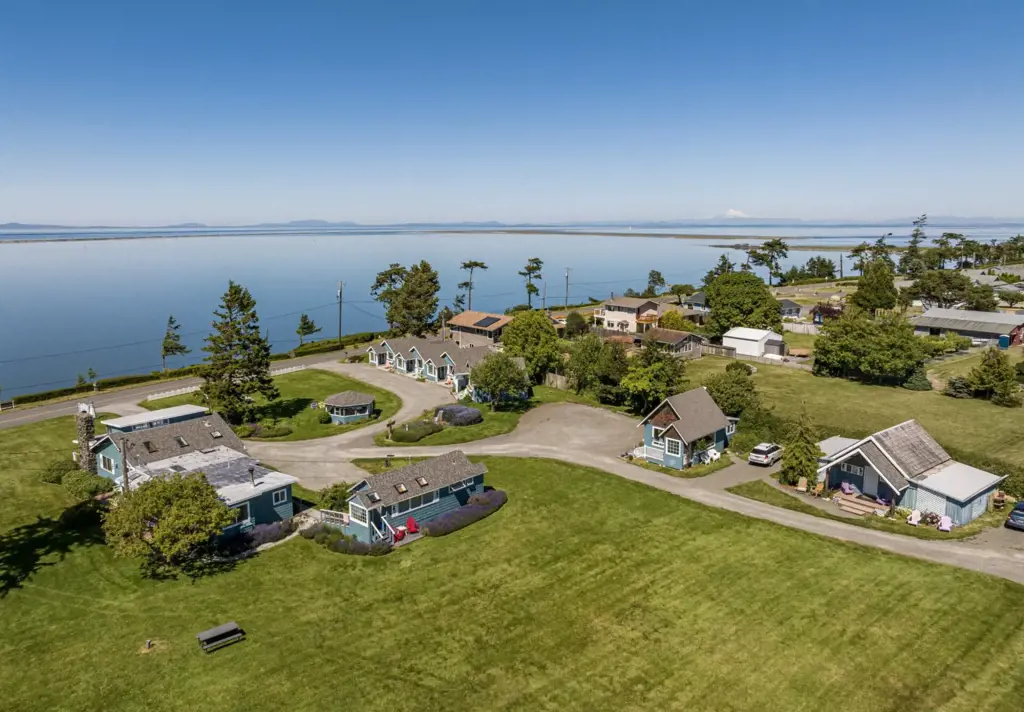
When planning a hiking or backpacking trip, one of the main considerations is whether to bring camping gear or rely on accommodations along the trail. The answer to this question depends on the specific trail you plan to hike and the amenities available.
In many cases, especially for longer and more remote trails, it is necessary to bring camping gear. This is because there may be limited or no accommodations along the trail. This is particularly true for trails in national parks, wilderness areas, and backcountry areas. These trails are often located in remote locations where it would be impractical to have accommodations such as hotels or cabins.
Bringing camping gear allows hikers to set up their own campsite and have a place to sleep, eat, and relax. It also provides a level of self-sufficiency and independence, allowing hikers to explore more remote and less crowded areas.
However, there are also many trails that offer accommodations along the route. These accommodations can range from simple camping areas with basic amenities such as toilets and water sources to fully equipped huts or lodges. These types of trails are more common in popular hiking areas and may be found in national parks, state parks, and other developed areas.
One example of a trail with accommodations is the Appalachian Trail. The trail stretches over 2,000 miles from Georgia to Maine and passes through various towns and cities along the way. Hikers can take advantage of hostels, lodges, and other accommodations in these towns to rest, resupply, and take a break from camping. This allows hikers to carry less gear and have a more comfortable experience on the trail.
When deciding whether to bring camping gear or rely on accommodations, it is important to consider factors such as the length and remoteness of the trail, the availability of accommodations, and personal preferences. Some hikers enjoy the solitude and simplicity of camping and prefer to carry their own gear, while others may prefer the convenience and comfort of accommodations.
It is also worth noting that even on trails with accommodations, it is still a good idea to carry some camping gear as a backup. In some cases, accommodations may be full or unavailable, and having a tent and sleeping bag can provide peace of mind and a backup plan.
In conclusion, the decision to bring camping gear or rely on accommodations along the trail depends on the specific trail and the amenities available. While some trails may offer accommodations, many trails require hikers to bring their own gear. It is important to research the trail beforehand and consider personal preferences and comfort levels when making this decision.
5 Essential Items to Pack for a Disney Trip with Toddlers
You may want to see also

Are there any special considerations for packing food on the Juan de Fuca Trail?
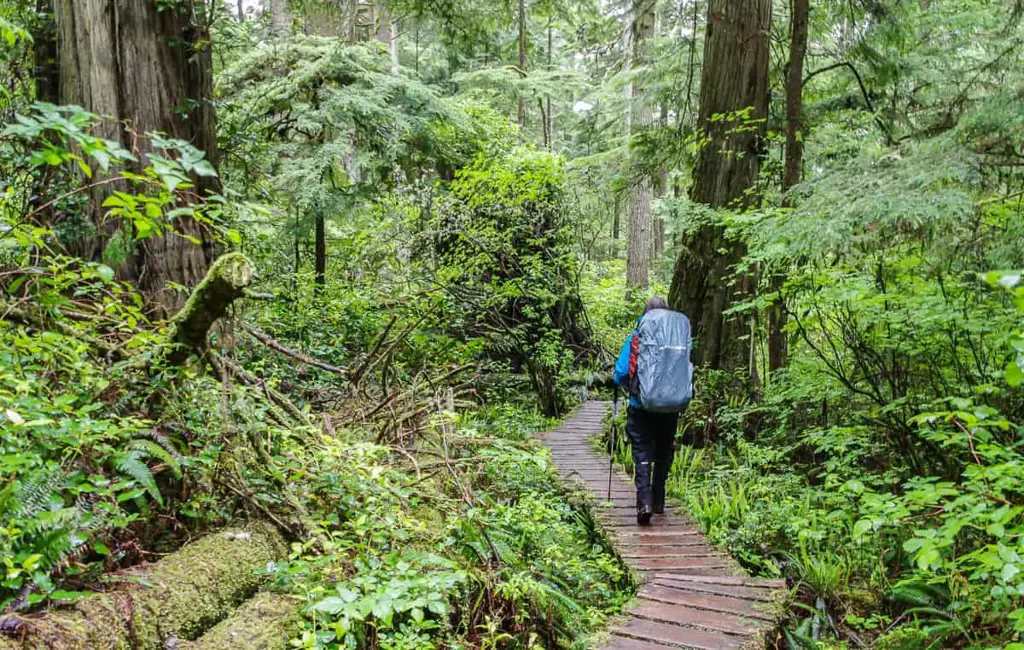
The Juan de Fuca Trail is a popular hiking trail located on Vancouver Island, British Columbia, Canada. It spans a distance of about 47 kilometers and can take anywhere from 3 to 5 days to complete. When embarking on a multi-day hike like the Juan de Fuca Trail, it is essential to carefully plan and pack your food to ensure you have enough energy and nutrition to sustain you throughout the journey.
Here are some special considerations for packing food on the Juan de Fuca Trail:
- Caloric density: Due to the physically demanding nature of the trail, you will be burning a significant amount of calories each day. Therefore, it is important to choose foods that are calorically dense to provide you with the energy you need. High-calorie options include nuts, nut butter, granola bars, and dried fruits.
- Lightweight and compact: Since you have to carry all your food with you, it is crucial to pack lightweight and compact options to reduce the weight and bulk in your backpack. Look for dehydrated meals, instant soup mixes, and freeze-dried fruits, which are not only lightweight but also have a longer shelf life.
- Nutritional balance: While it can be tempting to rely solely on energy bars and snacks, it is important to ensure you have a well-balanced diet to meet your nutritional needs. Try to include a mix of proteins, carbohydrates, and healthy fats in your meals. Pack items like canned tuna, jerky, whole-grain crackers, and individual packets of nut butter.
- Hydration: Staying hydrated is crucial during any hike, especially on a challenging trail like the Juan de Fuca. Along with packing enough water, consider bringing electrolyte tablets or powder to replenish the salts and minerals lost through sweat. These can easily be added to your water bottles.
- Packaged meals: Pre-packaged meals can be a convenient option, especially if you don't want to spend a lot of time cooking or if you prefer hot meals on the trail. There are various brands that offer dehydrated meals specifically designed for hiking. These meals only require hot water to rehydrate and are a great option for a hot, satisfying meal after a long day of hiking.
- Meal planning: Before heading out on the trail, create a meal plan that outlines what you will eat each day. This will help you ensure you have enough food to last the entire trip and prevent any food shortages. Consider the number of meals and snacks you will need each day and adjust quantities accordingly.
In conclusion, packing food for the Juan de Fuca Trail requires careful consideration of caloric density, weight, nutrition, and hydration. By planning your meals ahead of time and choosing lightweight, compact, and nutritious options, you can ensure that you have enough energy to tackle the challenging terrain and enjoy your hiking experience to the fullest.
What to Pack for a 7-Day Cruise to Mexico
You may want to see also

Are there any specific safety items that should be included in my pack?
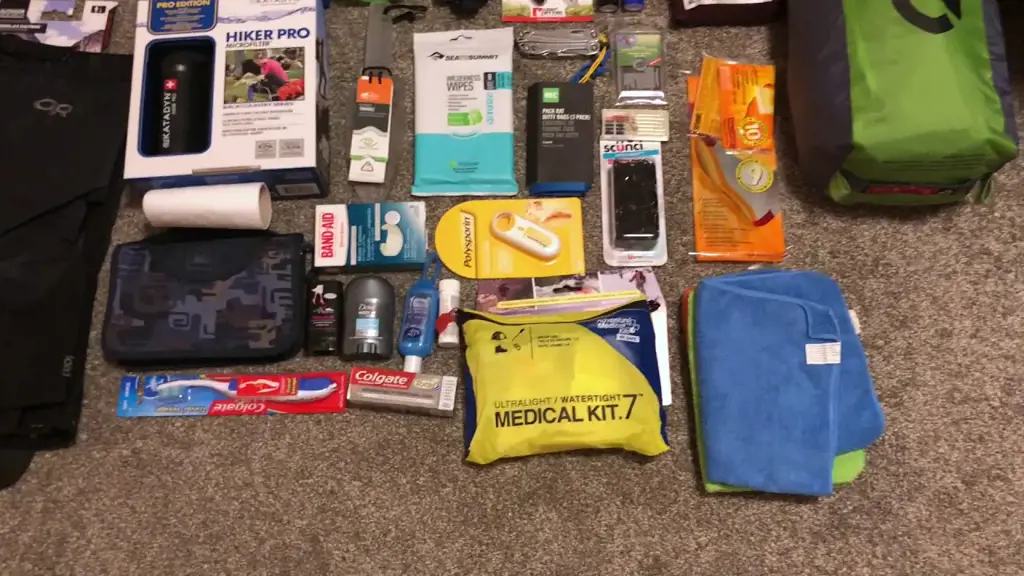
When preparing for any outdoor adventure, safety should always be a top priority. A well-packed backpack can make all the difference in case of emergencies or unexpected situations. Whether you're hiking, camping, or engaging in any outdoor activity, there are a few essential safety items that should always be included in your pack.
First Aid Kit:
A first aid kit is a must-have item for any outdoor adventure. It should contain the basic supplies to handle minor injuries such as cuts, scrapes, and burns. The kit should include adhesive bandages, antiseptic wipes, gauze pads, adhesive tape, tweezers, scissors, and pain relief medication. Additionally, it's a good idea to have any necessary personal medications packed separately.
Emergency Shelter:
Being prepared for unforeseen circumstances, such as getting lost or unexpected weather changes, is crucial. Pack a lightweight emergency shelter such as a bivy sack or a lightweight tent that can provide protection from the elements. This will help keep you warm and dry in case you need to spend the night outdoors.
Navigation Tools:
Carrying navigation tools such as a map, compass, or GPS device is essential to help you stay on track and find your way back to the trailhead or civilization if needed. It's important to know how to use these tools beforehand to ensure you can navigate effectively.
Whistle:
A whistle is a small and lightweight item that can be very useful in getting attention or signaling for help. It can be heard over long distances and is a universal distress signal. Keep it within reach, preferably attached to your backpack or on a lanyard around your neck.
Firestarter:
Having the ability to start a fire is essential for warmth, cooking, and signaling for help. Carry a reliable firestarter, such as waterproof matches or a waterproof lighter, in a sealed container. Additionally, pack some fire-starting materials such as cotton balls soaked in petroleum jelly or small tinder bundles to ensure you can start a fire even in wet conditions.
Headlamp or Flashlight:
A headlamp or flashlight is crucial for any outdoor adventure, especially if you plan on being out past sunset. Choose a lightweight and waterproof option with adjustable brightness settings to conserve battery life. Always bring extra batteries or ensure the batteries are fully charged before heading out.
Personal Locator Beacon (PLB) or Satellite Messenger:
If you'll be venturing into remote or wilderness areas, consider investing in a personal locator beacon or a satellite messenger. These devices can send distress signals and your GPS location to emergency services, enabling them to locate you quickly in case of an emergency.
Remember, the safety items mentioned above are just a starting point. Depending on the specific activity, location, and duration of your trip, you should tailor your pack to include any additional safety items that may be required. Always research and understand the potential risks associated with your chosen outdoor activity and pack accordingly. Additionally, it's essential to have proper training and knowledge on how to use the safety items in your pack effectively.
The Ultimate Checklist for Packing for a 14er Adventure
You may want to see also
Frequently asked questions
When packing for the Juan de Fuca trail, it is important to pack lightweight and waterproof clothing to prepare for any weather conditions. A good rain jacket and waterproof pants are essential. It is also wise to pack multiple pairs of hiking socks, as well as a sturdy pair of hiking boots. Other important items to pack include a tent, sleeping bag, camping stove, and cookware. Don't forget to bring a map and a compass, as well as a first aid kit and any necessary medications.
When planning your food supply for the Juan de Fuca trail, it is important to consider the length of your hike and the number of days you will be on the trail. A general rule of thumb is to pack 1.5-2 pounds of food per day per person. This should include a mix of calorie-dense foods such as nuts, granola bars, and trail mix, as well as dehydrated meals for dinner. It is also important to bring enough water or a water filtration system to last for your entire trek.
Yes, you can bring a tent or hammock for camping on the Juan de Fuca trail. Camping is allowed along the trail, and there are designated camping areas with tent pads where you can set up your tent. However, it is important to note that campsites are first-come, first-served, so it is a good idea to arrive early to secure a spot. If you prefer hammock camping, make sure to bring sturdy straps and look for trees with adequate spacing for setting up your hammock.
If you are hiking the Juan de Fuca trail in the offseason, there are a few additional considerations for your packing list. The weather can be colder and wetter, so it is important to pack warm layers, including thermal underwear, insulated jackets, hats, and gloves. Additionally, you may encounter more difficult and slippery conditions on the trail, so it is important to pack trekking poles and traction devices for your shoes. It is also a good idea to check the trail conditions and any trail closures or warnings before embarking on your hike.


